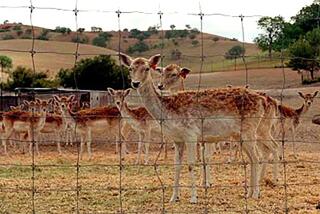New Wildlife Refuge in Washington State Seen
- Share via
WASHINGTON — The Energy Department will announce today that it wants to preserve as a wildlife refuge 90,000 acres once used as part of the top-secret project to build the atomic bomb.
The agency later this month will formally propose designating the land in Washington state to be managed by the U.S. Fish and Wildlife Service.
The area was a security buffer for the Hanford nuclear reservation, constructed in 1943 for the Manhattan Project to build the bomb during World War II. Hanford made plutonium for the nation’s nuclear arsenal until the 1980s and is now being cleaned up as the most contaminated nuclear site in the nation.
But much of the land in the security buffer has been untouched for decades and is considered to be in near pristine condition.
“We want to come to terms with our past,” Energy Secretary Bill Richardson said Friday. “We created a mess there, we’re cleaning it up, but now for future generations we want to pay back Washington state and that community.”
Richardson plans to announce the wildlife refuge proposal at a news conference today in Washington state.
If the proposal clears all state and federal administrative hurdles, the area could become a refuge in November, thus protecting the land from development or agricultural uses.
Currently, one-third of the area is being managed as a federal wildlife refuge and the other two-thirds is being managed by the state as a recreation area. Washington Gov. Gary Locke, a Democrat, said he supports managing all the land as a federal refuge.
Conservation groups say the land, known as the Wahluke Slope, is home to more than 200 species of birds and more than 40 rare plants and animals, such as the long-billed curlew bird and the White Bluffs bladder-pod, a bright yellow flower that blooms each June.
The environmentalists have been working for more than a decade to preserve what they consider one of the last large chunks of high-quality shrub-steppe habitat in the nation.
“We think this is just a giant step forward,” said Rick Leaumont of the Lower Columbia Basin Audubon Society. “For many years now there’s been this uncertainty of what was going to happen with the land.”
Now with the slope moving toward protection, environmentalists want to try to keep 51 miles of the Columbia adjacent to the slope off-limits.
The Hanford Reach is the last free-flowing stretch of the Columbia and a critical spawning ground for salmon. It was, like the slope, left untouched because of the nuclear reservation.
More to Read
Sign up for Essential California
The most important California stories and recommendations in your inbox every morning.
You may occasionally receive promotional content from the Los Angeles Times.













